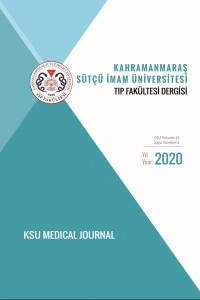Posterior Reversibl Ensefalopati Sendromu: Sistemik Lupus Eritematozuslu hastalarda görülen nadir ve acil klinik bir antite
Öz
Özet
PRES hipertansiyon,
başağrısı, konfüzyon, nöbet, görme değişiklikleri ile karakterize posterior serebral
dolaşımda (beyin sapı, serebellum, parietal lob, temporal lob, oksipital lob ve
posterior ön lob dahil olabilen) vazojenik ödem şeklinde görülen klinik ve
radyolojik bir antitedir. PRES
sendromlu hastaların yaklaşık yarısında sistemik
lupus eritematozus (SLE) gibi otoimmün bir hastalık öyküsü vardır. PRES
sendromu gelişen SLE hastalarında erken tanı ve tedavi önemlidir. Bu sayede
çoğunlukla benign gidişatlı bir hastalık erkenden tanınmış olur ve gereksiz
tetkiklerin önüne geçilebilir.
Abstract:
PRES is a
clinical and radiological entity in the form of vasogenic edema in the
posterior cerebral circulation (including brain stem, cerebellum, parietal
lobe, temporal lobe, occipital lobe and posterior anterior lobe) characterized
by hypertension, headache, confusion, seizures, visual changes. Approximately
half of patients with PRES syndrome have a history of autoimmune disease such
as systemic lupus erythematosus (SLE). Early diagnosis and treatment are
important in SLE patients with PRES syndrome. In this way, usually a benign
disease is recognized early and unnecessary examinations can be prevented.
Anahtar Kelimeler
Posterior Reversibl Ensefalopati Sendromu Sistemik Lupus Eritematozus
Kaynakça
- 1. Hinchey J, Chaves C, Appignani B, et al. A reversible posterior leukoencephalopathy syndrome. N Engl J Med 1996; 334:494.
- 2. Cui HW, Lei RY, Zhang SG, et al. Clinical features, outcomes and risk factors for posterior reversible encephalopathy syndrome in systemic lupus erythematosus: a case-control study. Lupus 2019; 28, 961–969.
- 3. Damrongpipatkul U, Oranratanachai K, Kasitanon N and et al. Clinical features, outcome, and associated factors for posterior reversible encephalopathy in Thai patients with systemic lupus erythematosus: a case-control study. 2018; 37: 691–702.
- 4. Pande A, Kumiko A, Ishikura R, et al. Clinicoradiological Factors Influencing the Reversibility of Posterior Reversibl Encephalopathy Syndrome: A Multicenter Study. Radiation Medicine 2006; 24: 659–668.
- 5. Dong XY, Bai CB, Nao JF. Clinical and radiological features of posterior reversible encephalopathy syndrome in patients with preeclampsia and eclampsia. Clin Radiol 2017; 72: 887–895.
- 6. Jung SM, Moon SJ, Kwok SK, et al. Posterior reversible encephalopathy syndrome in Korean patients with systemic lupus erythematosus: Risk factors and clinical outcome. Lupus 2013; 22: 885–891.
- 7. Bertsias GK, Ioannidis JP, Aringer M, et al. EULAR recommendations for the management of systemic lupus erythematosus with neuropsychiatric manifestations: report of a task force of the EULAR standing committee for clinical affairs. Ann Rheum Dis. 2010; 69:2074-82.
- 8. Hanly JG, McCurdy G, Fougere L , et al. Neuropsychiatric events in systemic lupus erythematosus: attribution and clinical significance. J Rheumatol. 2004; 31:2156-2162.
- 9. Dardis C, Craciun R, Schell R. Posterior reversible encephalopathy syndrome in the setting of COPD: Proposed pathogenesis. Med Hypotheses 2013; 80: 197–200.
- 10. Lee SC, Dickson DW, Liu W, et al. Induction of nitric oxidesynthase activity in human astrocytes by interleukin-1 beta and interferon-gamma. J Neuroimmunol 1993; 46: 19–24.
- 11. Stott V, Hurrell M, Anderson T. Reversible posterior leukoencephalopathy syndrome: A misnomer reviewed. Journal of Internal Medicine 2005;35, 83–90
- 12. Van Diest D, Van Goethem J, Vercruyssen A, et al. Posterior reversible encephalopathy and Guillain‐Barre syndrome in a single patient: Coincidence or causative relation? Clinical Neurology and Neurosurgery, 2007; 109, 58–62.
- 13. Gark, R. Posterior leukoencephalopathy syndrome. Journal of Postgraduate Medicine 2001; 77, 24–28.
- 14. Adams H, Adams R, Del Zopp G, et al. Stroke Council of the American Heart Association, The American Stroke Association. Guidelines for the early management of patients with ischemic stroke: 2005 guidelines update, a scientific statement from the stroke council of the American Heart Association and the American Stroke Association. Stroke 2005; 36, 916–923.
- 15. Covarrubias DJ, Luetmer PH, Campeau NG. Posterior reversible encephalopathy syndrome: prognostic utility of quantitative diffusion-weighted MR images. AJNR Am J Neuroradiol 2002; 23:1038.
- 16. Chou MC, Lai PH, Yeh LR, et al. Posterior reversible encephalopathy syndrome: Magnetic resonance imaging and diffusion weighted imaging in 12 cases. Kaohsiung J MedSci2004; 20:381–388.
- 17. Schwartz RB, Jones KM, Kalina P, et al. Hypertensive encephalopathy: findings on CT, MR imaging, and SPECT imaging in 14 cases. AJR Am J Roentgenol 1992; 159:379.
- 18. Servillo G, Bifulco F, De Robertis E, et al. Posterior reversible encephalopathy syndrome in intensive care medicine. Intensive Care Medicine 2006; 21.
- 19. Robakis T, Hirsch L. Literature review, case report, and expert discussion for prolonged refractory status epilepticus. Neurocritical Care 2006; 4, 35–46.
- 20. Marchetti A, Magar R, Fischer J, et al. A pharmacoeconomic evaluation of intravenous fosphenytoin (Cerebyx) versus intravenous phenytoin (Dilantin) in hospital emergency departments. Clinical Therapeutics 1996; 18, 953–966.
- 21. Fugate JE, Rabinstein AA. Posterior reversible encephalopathy syndrome: Clinical and radiological manifestations, pathophysiology, and outstanding questions. Lancet Neurol 2015; 14:914–925.
- 22. Mukherjee P, McKinstry RC. Reversible posterior leukoencephalopathy syndrome: evaluation with diffusion-tensor MR imaging. Radiology 2001; 219:756.
- 23. Legriel S, Schraub O, Azoulay E, et al. Determinants of recovery from severe posterior reversible encephalopathy syndrome. PLoS One 2012; 7: e44534.
- 24. Damrongpipatkul U, Oranratanachai K, Kasitanon N, et al. Clinical features, outcome, and associated factors for posterior reversible encephalopathy in Thai patients with systemic lupus erythematosus: A case-control study.Clin Rheumatol 2018; 37: 691–702.
- 25. Lai CC, Chen WS, Chang YS, et al. Clinical features and outcomes of posterior reversible encephalopathy syndrome in patients with systemic lupus erythematosus. Arthritis Care Res (Hoboken) 2013; 65: 1766–1774.
Ayrıntılar
| Birincil Dil | Türkçe |
|---|---|
| Konular | Sağlık Kurumları Yönetimi |
| Bölüm | Derlemeler |
| Yazarlar | |
| Yayımlanma Tarihi | 8 Temmuz 2020 |
| Gönderilme Tarihi | 27 Eylül 2019 |
| Kabul Tarihi | 4 Kasım 2019 |
| Yayımlandığı Sayı | Yıl 2020 Cilt: 15 Sayı: 2 |


